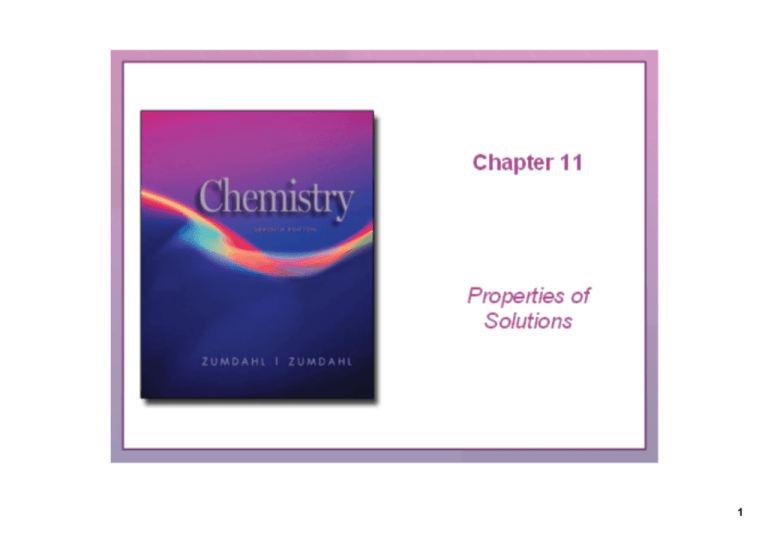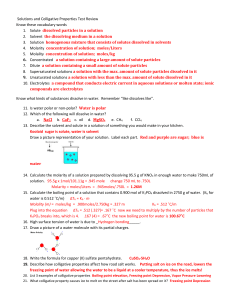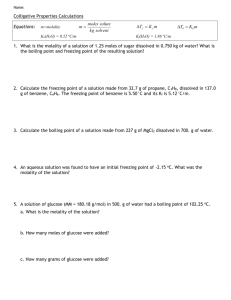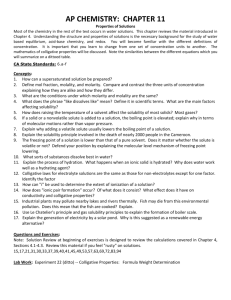Boiling Point Elevation
advertisement

1 11.1 Solution Composition • Solve problems relating to the mass percent, mole fraction and molality. 2 • Molarity (M) is defined as moles of solute per liter of solution. M = moles of solute liter of solution • Mass Percent is the percent by mass of the solute in the solution. Mass Percent = (mass of solute/mass of solution) x 100% • Mole Fraction (chi χ A) is the ratio of the number of moles of a given component to the total number of moles of solution n A χA = = number moles of A Mole Fraction of A = n A + n B total number of moles • Molality ( m) is the number of moles of solute per m = moles of solute kilogram of solvent kilogram of solvent The molarity will be equal to the molality only in very dilute aqueous solutions. Example. 11.1 A Concentration Units A solution was prepared by adding 5.84 g of formaldehyde, H 100.0 g of water. The final volume of the solution was 104.0 mL. Calculate the molarity, molality, mass percent, and mole fraction of the formaldehyde in the solution. 2 CO, to 3 11.3 Factors Affecting Solubility When you finish this section you will be able to: • Predict relative Solubilities of simple molecules based on structure. In considering solubility effects it is important to separate the behavior of solids and liquids from gases. independent of structure. The solubility of gases is for the most part Solid and liquid solubility is highly structure dependent. Read the discussion in your textbook on “structure effects” as it relates to the solubilities of vitamins A and C, then work the next example. Example 11.3A Structure and Solubility Determine whether or not each of the following compounds is likely to be water soluble. a. H3 C – CHNH 2 | OH c. C4 H9 – C = CH | H b. H | H2 C – N – C | NC 6 H5 d. 6 H5 2 CH3 (CH 2 ) 4 CH2 NH2 e. H2 C – CH | | OH OH 2 4 Pressure Effects Pressure has little effect on the solubility of solids and liquids. Pressure significantly increases the solubility of gas. Temperate Effects (for Aqueous Solutions) The solubilities of several solids as a function of temperature. Most substances become more soluble in water with increasing temperature, sodium sulfate and cerium sulfate become less soluble 5 11.5 Boiling Point Elevation and Freezing Point Depression When you finish this section you will be able to solve problems relating to the colligative properties of boiling point elevation and freezing point depression. The presence of a solute affects the freezing and boiling point of a solvent. Freezing point depression, boiling point elevation and osmotic pressure are . called colligative properties Colligative properties depend only on the not on the nature of the particles. concentration of solute particles , Boiling Point Elevation ­ is the increase in boiling point of a liquid due to the addition of a nonvolatile solute. The boiling point elevation, ΔT, is given by ΔT = Kbmsolute where: ΔT is the boiling point elevation (in °C) Kb is the molal boiling point elevation constant (in °C kg/mol ) m is the molality of the solute (in mol solute/kg solvent ) 6 Freezing Point Depression ­ is the decrease in freezing point of a liquid due to the addition of a nonvolatile solute. The freezing point depression, ΔT, is given by ΔT = Kf msolute where: ΔT is the freezing point depression (in °C) Kf is the molal freezing point depression constant (in m is the molality of the solute (in mol solute/kg solvent °C kg/mol ) ) Phase Diagrams for Pure Water (Red) and for an Aqueous Solution Containing a Nonvolatile Solute (Blues) Note: The B.P of the solution is higher than that of pure water. The F.P of the solution is lower than that of pure water. The effect of a non­volatile solute is to extend the liquid range of the solvent 7 The table above gives values of Kb and K f for some common solvents. Keep in mind that much useful information can be obtained from colligative property experiments, including molar mass of the solute, molality, and mass percent. Example 11.5B Freezing Point Depression How many grams of glycerin (C 3 H8 O3 ) must be added to 350.0 g water in order to lower the freezing point to –3.84°C (K f for water = ­1.86°C kg/mol)? 8 11.6 Osmotic Pressure When you finish this section you will be able to solve problems regarding osmosis and molar mass. Osmosis is the flow of solvent into a solution through a semipermeable membrane. Osmotic pressure is the pressure that just stops the osmosis. colligative property Osmotic pressure is a because its value depends on the concentration of the solute, not its nature. Osmotic pressure is especially small solute useful for determining molar masses experimentally because concentrations produce large osmotic pressures. 9 The relationship between osmotic pressure and solution concentration is given by Π = MRT where: Π is the osmotic pressure (in M is the molarity of the solute (in R is the universal gas constant ( T is the temperature (in atm ) mol/L ) 0.08206 atm L/K mol ) K) Example 11.6 Osmotic Pressure The osmotic pressure of a solution containing 26.5 mg of aspartame per litter is 1.70 torr at 30°C. Calculate the molar mass of aspartame. 10 11.7 Colligative Properties of Electrolyte Solutions At the end of this section you will be able to solve colligative property problems requiring the van't Hoff factor Nonelectrolytes do not ionized when introduced into water and each molecule keeps its identity and remains as an entity. electrolytes On the other hand, will ionize and each ion will act as an entity. Therefore, equimolal solutions of electrolytes will have higher osmotic pressures (and all other colligative properties) than equimolal solutions of nonelectrolytes. The relationship between the moles of solute dissolved and moles of particles van't Hoff factor in the solution is expressed in using the For example, for NaCl, (Na i , is 3. For Fe 3 (PO 4 ) 2 (3Fe + and Cl ­ ), i , is 2. For K +3 , and 2PO 4 ­3 ), i , is 5. , i. 2 SO4 , (2K + and SO 4 2­ ), 11 Therefore, the freezing point depression of a solution of an electrolyte becomes: ΔT = iK f msolute The boiling point elevation of a solution of an electrolyte becomes: ΔT = iK bmsolute The osmotic pressure of a solution of an electrolyte becomes: Π = iMRT Example How many grams of NaCl must be added to 1.00 L of water to decrease the freezing point to −6°C? Example 11.5A Boiling Point Elevation A solution is prepared by adding 31.65 g of sodium chloride to 220.0 mL of water at 34.0°C (density = 0.994 g/mL, K b for water is 0.51°C kg/mol). Calculate the boiling point of the solution, assuming complete dissociation of NaCl in solution. 12








